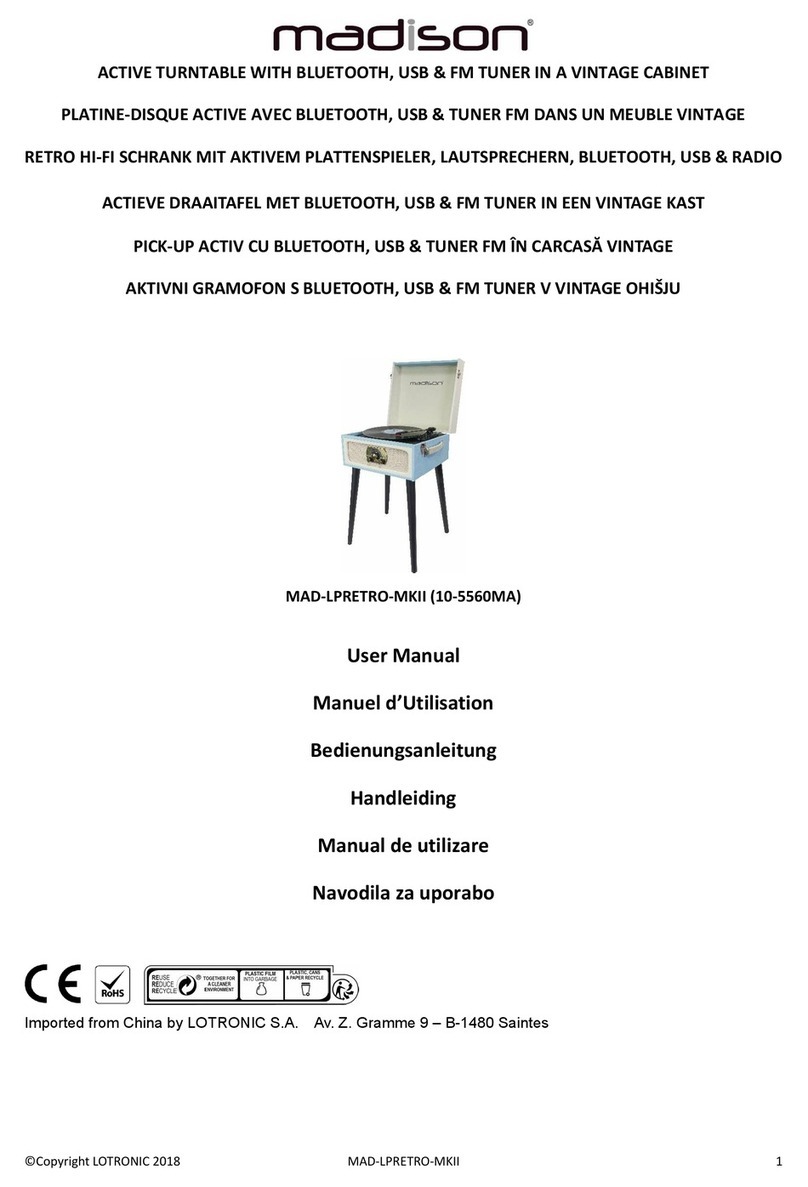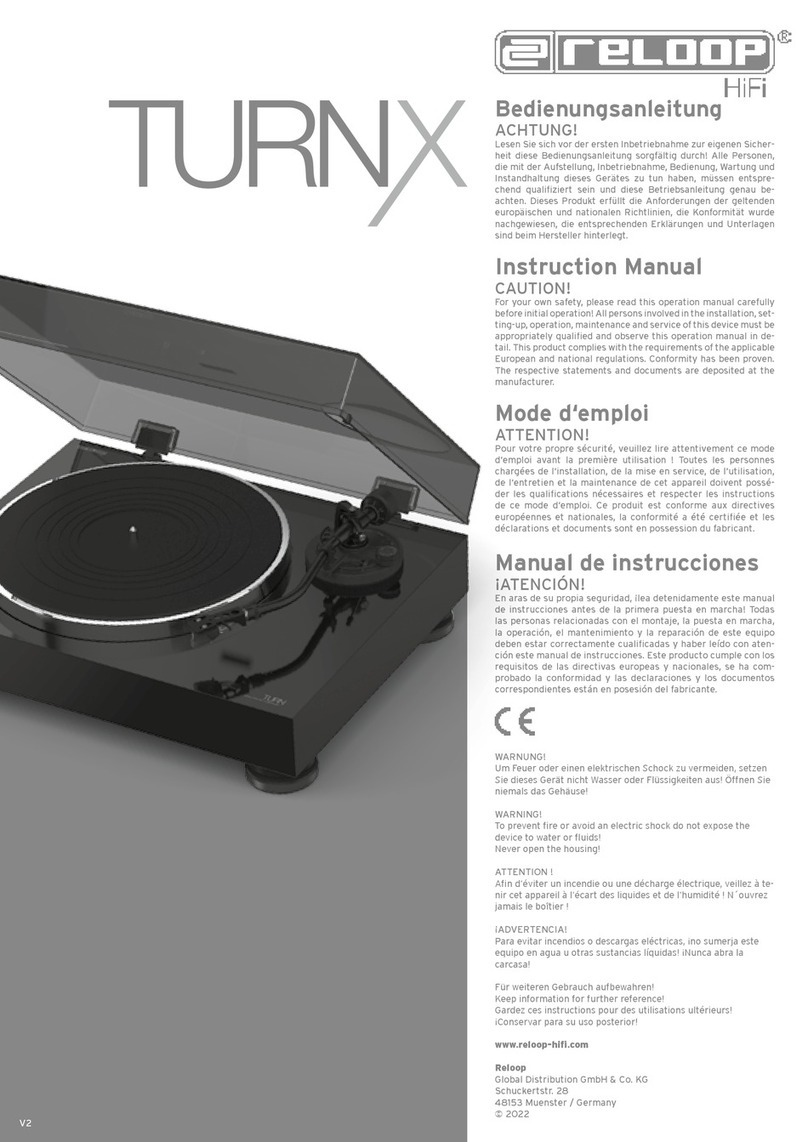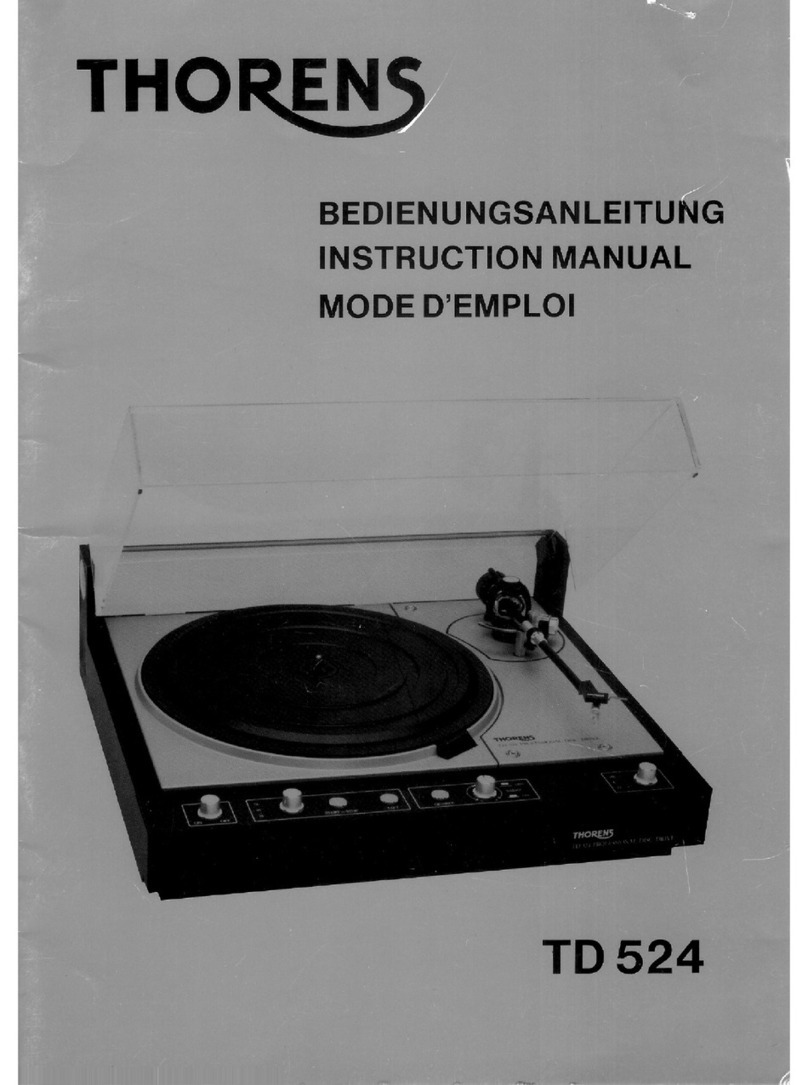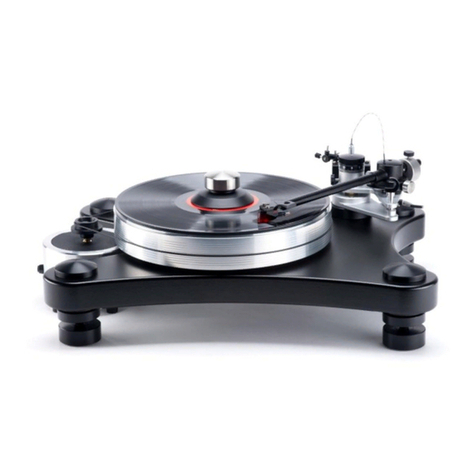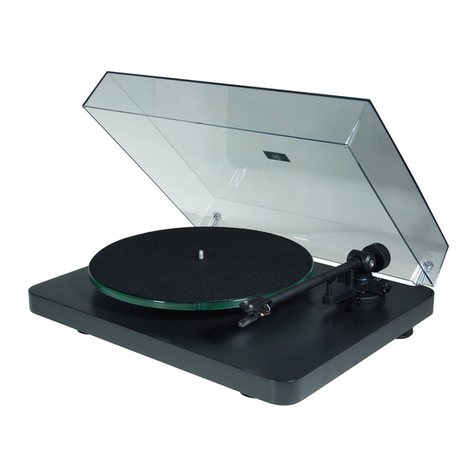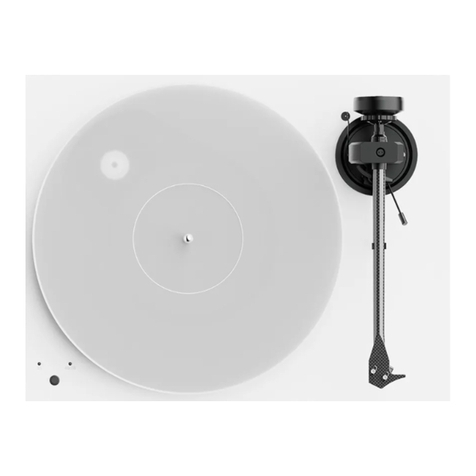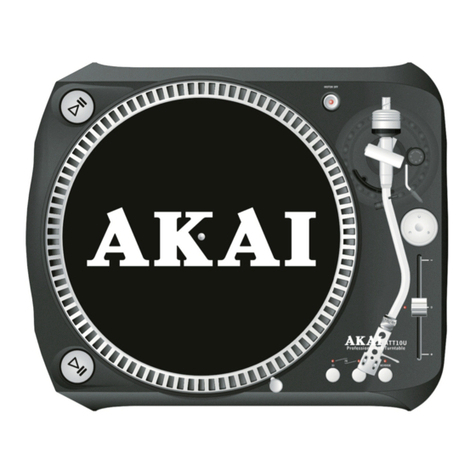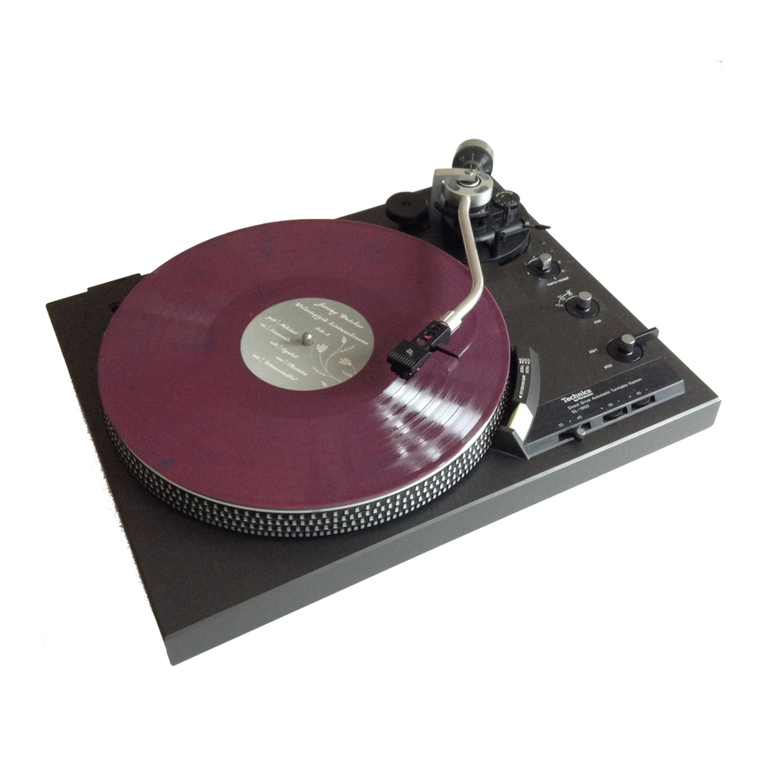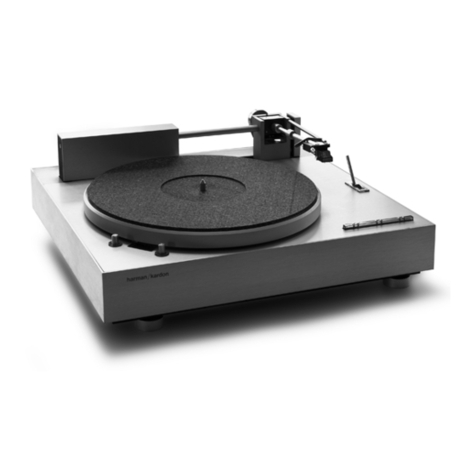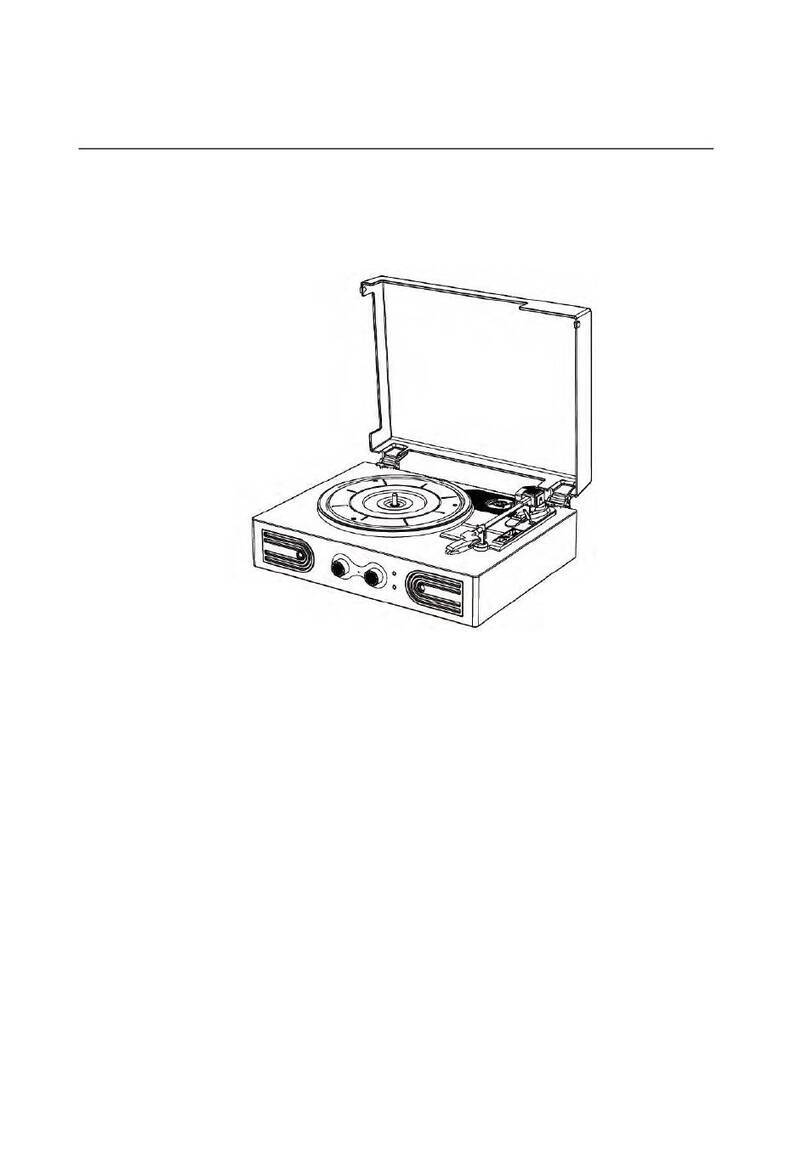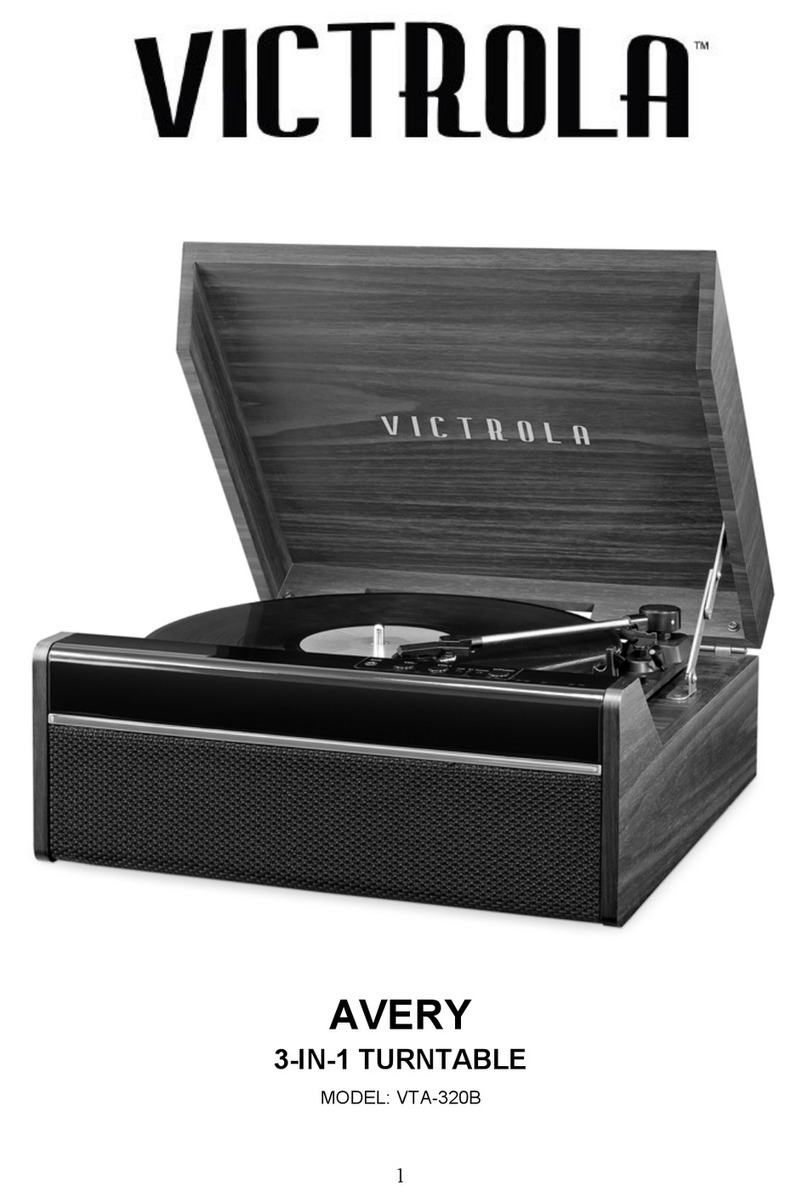Madison MAD-RT500-BK User manual

MAD-RT500-BK / MAD-RT500-WD
Code: 10-5558/ 10-5559
BELT-DRIVE TURNTABLE
with USB ENCODING, BLUETOOTH TRANSMISSION & AUDIO TECHNICA®CARTRIDGE
PLATINE-DISQUES A ENTRAINEMENT PAR COURROIE
avec ENCODAGE USB, TRANSMISSION BLUETOOTH & CELLULE AUDIO TECHNICA®
PLATTENSPIELER MIT RIEMENANTRIEB
PC ENCODING, BLUETOOTH ÜBERTRAGUNG & AUDIO TECHNICA®TONABNEHMER
USB BELT-DRIVE PLATENSPELER
met PC ENCODING, BLUETOOTH OVERDRACHT & AUDIO TECHNICA®CARTRIDGE
BELT-DRIVE GRAMOFON
Z USB ENKODIRANJEM, BLUETOOTH PRENOSOM IN AUDIO TECHNICA®GLAVO
PLATAN CU CUREA
cu USB, TRANSMISIE BLUETOOTH & CARTUȘ AUDIO TECHNICA®
GIRADISCOS TRACCION POR CORREA
Con ENCODER USB, TRANSMISION BLUETOOTH & CAPSULA AUDIO TECHNICA®
USER MANUAL - p. 2
MANUEL D'UTILISATION- p. 10
BEDIENUNGSANLEITUNG- p. 18
HANDLEIDING- p. 26
NAVODILA ZA UPORABO- p. 34
MANUAL DE UTILIZARE- p. 42
MANUAL DE USUARIO- p. 50

ENGLISH
2
© Copyright LOTRONIC 2019
BELTDRIVE TURNTABLE WITH USB ENCODING, BLUETOOTH TRANSMISSION
& AUDIO TECHNICA® CARTRIDGE
Operating Instructions
Congratulations to the purchase of your new turntable.
Warnings
CAUTION
DO NOT OPEN THE HOUSING
SHOCK HAZARD
Explanation of signs
The triangle containing a lightning symbol is used to indicate whenever your health is at risk (due to electro-
cution, for example).
An exclamation mark in a triangle indicates particular risks in handling or operating the appliance.
Safety instructions
• Read, follow and keep these Instructions for future reference.
• Do not use this apparatus near water.
• Clean only with a damp cloth.
• Do not block any of the ventilation openings. Install in accordance with the manufacturer’s instructions.
• Do not install near by heat sources such as radiators, heat registers, stoves, or other apparatus (including am-
plifiers) that produce heat.
• Protect the power cord from being walked on or pinched particularly at plug, convenience receptacles, and
point where they exit from the apparatus.
• Only use attachments/accessories specified by the manufacturer.
• Use only with a cart, stand, tripod, bracket, or table specified by the manufacturer, or sold with the apparatus.
• Unplug this apparatus during lighting storms or when unused for long periods of time.
• Refer all servicing to qualified service personnel. Serving is required when the apparatus has been damaged in
any way, such as power-supply cord or plug is damaged, liquid has been spilled or objects have fallen into the
apparatus, the apparatus has been exposed to rain or moisture, does not operate normally, or has been drop-
ped.
• This mains plug is used as the disconnect device, the disconnect device shall be readily operable.
Contents of the carton:
1) Unit
2) Power Adaptor
3) Counterweight
4) Platter with Belt
5) 45 RPM Adaptor
6) Turntable mat
7) Instruction Manual
8) Cartridge Alignment Protractor
9) USB-PC Cable
10) Anti-skating Weight
This turntable is supplied with a factory fitted and adjusted cartridge.
**The following instructions for adjusting the cartridge are provided in case the cartridge is replaced by a diffe-
rent model at a later date.

MAD-RT500-BK / MAD-RT500-WD
3
© Copyright LOTRONIC 2019
COMPONENTS, FEATURES AND CONNECTIONS
1. Counterweight
2. Anti-skating Stub
3. Turntable Platter
4. Tonearm Lift Lever
5. Tonearm Rest
6. 33/45 Selector
7. Tonearm
8. Stop/Start Knob
9. Cartridges
10. Lid
11. Lid Hinge
12. Ground Connector
13. PHONO & Line Out Jacks
14. PHONO & Line Out Switch
15. Anti-skating Weight
16. USB-PC port
17. AC-DC Power Jack
18. Bluetooth Indicator
19. Power Rocker Switch
Installing the Lid
Install the Lid carefully over the hinge prongs.
Turntable Platter and Belt Setup
1. Install the drive belt over the inner ring under the platter and make sure it
won’t fall off during the setup.
2. Place the platter on the turntable spindle, then rotate the platter until you
see the drive motor pulley through the window at the top left corner.
3. Carefully grab the drive belt and put it around the slot of motor pulley.
4. Connect the power adapter to the turntable and power on the turntable.
5. Set the Motor Start/Stop switch to the Start position to see if the platter mo-
tor spins. If the platter does not spin, try the steps listed above again.
Cartridge Down force Adjustment
The Counterweight supplied is suitable for cartridges weighing between 3.0-6.0g.
• Gently push and turn the Counterweight onto the rear of the tonearm (with the scale facing towards the front of
the turntable).
• Remove the cartridge protection cap.
• Lower the tonearm lift and position the cartridge in the space between tonearm rest and platter.
• Carefully rotate the Counterweight until the tonearm balances out. The tonearm should return to the balanced
position if it is moved up or down. This adjustment must be done carefully.
• Once the tonearm is correctly balanced return it to its’ rest. Hold the Counterweight without moving it, and
gently rotate the Down force Scale ring until the zero is in line with the black line on the rear of the tonearm.
Check whether the arm still balances out.
• Rotate the counterweight counter clockwise (seen from the front) to adjust the down force according to the
cartridge manufacturer’s recommendations. One mark on the scale represents 0.05g of down force.
NOTE: The recommended down force for the factory fitted cartridge is 3.5±0.5g.
Anti-skating force adjustment
The anti-skating force must be adjusted corresponding to the down force as follows:

ENGLISH
4
© Copyright LOTRONIC 2019
Down force Groove in the stub
5 - 10mN 1 st from bearing rings
10 - 15mN 2 nd " " "
15 - 20mN 3 rd " " "
20mN and bigger 4 th" " "
Slip the loop of the anti-skating weight's thread over the 4th groove of the stub to set the correct anti-skating
force for the factory-fitted cartridge. Feed the thread through the loop of the wire support.
Connection to the Amplifier
This turntable uses a moving magnetic cartridge. Set the PHONO & Line Out Switch to PHONO mode. Connect
the phono output cables to the phono input on your amplifier or pre-amplifier (phono stage). Line inputs such as
CD, Tuner, Tape, or Video are not suitable for phono inputs. Make sure the amplification of the selected input
matches the type of cartridge being used. The factory installed cartridge is 47k ohms / MM-input.
NOTE: If your amplifier does not have an input suitable for phono cartridges, you will need to purchase a separate phono amplifier for
moving magnetic cartridges. This separate phono amplifier will then connect between your turntable and your amplifier.
Stereo System Connection
Set the PHONO & Line Out Switch to LINE mode. The RCA PHONO & Line Out Jacks generate analog line-level si-
gnals and could be connected directly to a pair of active/ powered speakers to the appropriate input of your stereo
system.
The Red plug connects to the Right channel and the White plug connects to the Left channel.
NOTE: The RCA Jacks are not designed to be connected directly to the passive/ unpowered speakers in LINE mode. If they are connec-
ted to the passive speakers, no sound will come out.
Main Power Connection
The power adaptor is in the foam packing material. Unpack the power adaptor and plug the small end into the DC
power jack located at the back side of the turntable. Plug the power adaptor into your power outlet.
Operation
Turntable Operation
1. Connect the included power adapter to the unit and press the power rocker switch to “ON” position.
2. Remove the needle cover from the cartridge.
3. Place the slipmat on the platter and place a record on the slipmat. If using 45 RPM records, put the 45 RPM
adapter on the center spindle before placing the record on the platter.
4. Set the 33/45 RPM Selector according to the type of record.
5. Turn the Start/Stop dial to the Start position to begin spinning the platter.
6. Unlock the arm clip and set the Lift Lever to the up position.
7. Position the tonearm over the desired location (groove) on the record.
8. Move the tonearm lift lever to the down position to place the tonearm on the record. Alternatively, place the
needle over the desired location on the record.
9. Carefully lower the tonearm on the record.
10. When you are finished playing the record, raise the tonearm, return it to rest on the arm clip, and turn the
Start/Stop dial to the Stop.
Bluetooth Operation
This unit has a Bluetooth transmitter to send the sound wirelessly to a Bluetooth speaker.
1. Power on your Bluetooth speaker and ensure it is in pairing mode.
2. Power on the unit, the BT will auto search when the unit is turned on. The BT indicator light is flashing.
3. During pairing, the light will flash twice per second. If the unit has been paired successfully, the light stays on.
Note: This unit will connect to the closest Bluetooth speaker. If after 2 minutes no Bluetooth speaker can be found
to pair with, the Bluetooth transmitter will become inactive and the LED will turn off.
4. To disconnect pairing, power off the turntable or deactivate the Bluetooth search on your Bluetooth speaker.
Recording the LP on your PC via the USB jack:
For installing and recording please follow the instruction in the BRIEF INTRODUCTION OF AUDACITY. http://auda-
city.sourceforge.net/

MAD-RT500-BK / MAD-RT500-WD
5
© Copyright LOTRONIC 2019
Recording the vinyl to your computer:
1). Follow the steps above Turntable Operation to play the vinyl.
2). Double click on the Audacity software and follow the steps in the BRIEF INTRODUCTION OF AUDACITY.
Audacity and USB Connection
It supports Windows95 / Windows XP / Windows 7 / Vista or more advanced versions.
Instruction for PC Encoding
Software instruction
1.1) Connect the USB cable to your turntable and your computer. No extra driver is required.
1.2) Download the Audacity software from http://audacity.sourceforge.net/
Follow the instructions to complete installation.
2. Recording
2.1) Open the software
2.1) Choose “Edit” menu, then choose “Preferences”;
2.3) Audacity Preferences
NOTE: you need to check your computer audio properties, the sound recording should be selected: SSS USB Audio
Device as below:

ENGLISH
6
© Copyright LOTRONIC 2019
2.4) Adjust the output and input volume
Output volume Input Volume
2.5) Select the record button ●to record the disc, the left and right tracks will show on the interface:
2.5.1 Press this button to start recording.
2.5.2 Click the button to skip to start;
2.5.3 Click the button to skip to end;
2.5.4 Click the button to play;
2.5.5 Click the button to pause the record play;
2.5.6 Click the button to stop the recording.
3. Export the Music Files for WAV, MP3, Format.
·Once you have finished recording, you should save your music to the computer.
·Click File menu and move down to Export as WAV format, MP3 format or Ogg format.
·Click on any format to save the music, and you will be asked for the file name of the music recording.
·Note: Audacity does not export MP3 files directly; you should download the LAME MP3 encoder. A link to find LAME MP3 can be found
at http://audacity.sourceforge.net
If do not see the sound wave on the interface, when recording, please adjust the line in volume as follows:

MAD-RT500-BK / MAD-RT500-WD
7
© Copyright LOTRONIC 2019
Specific Steps as follows:
1. Download “lame_enc.dll” file, and install it to the software list.
2. Open the “Audacity”software, click Main Menu, Select “edit”, “Parameter”, “File Formats”, and click the
“Searcher”.
3. After opened, it will come to the following menu, click “YES” to go to “Llame_enc.dll”, and find the file’s loca-
tion.
4. After you find the “lame_enc.dl” file, open it and click “Y” to finish the installation.

ENGLISH
8
© Copyright LOTRONIC 2019
Maintenance and Cleaning
Your turntable requires little or no regular maintenance. Remove dust with a slightly damp antistatic cloth. Never
use a dry cloth, this will create static electricity and attract more dust! Antistatic cleaning agents are available at
specialist stores, but must be applied sparingly to avoid damage to rubber parts. It is recommended to install the
needle cover before cleaning or maintenance is carried out to avoid damage.
If the turntable is not used over a long period of time, the drive belt should be removed to prevent unequal
stretching.
NOTE: Always disconnect the record player from the power supply as a precaution before maintenance!
Useful Tips
The turntable should be positioned on a low-resonance surface such as wood or multiple layer ply board to avoid
structural vibrations disturbing playback.
Cartridge Replacement
1. Before replacement, put the stylus protector back on the stylus to prevent damage to the stylus during the
replacement process.
2. Carefully remove the wire leads from the original cartridge.
3. Loosen the two screws on the headshell that are securing the cartridge and then remove the original cartridge.
4. Mount the new cartridge to the headshell and tighten it lightly. Do not completely tighten the screws at this
moment.
5. Connect the wire leads to the new cartridge’s terminals. The wire lead color codes are as below:
White Left channel positive (L+)
Black Left channel negative (L–)
Red Right channel positive (R+)
Black Right channel negative (R-)
6. Adjust the cartridge’s position to make sure it is accurately aligned on the headshell so that the stylus will be
tracking the grooves perfectly in parallel.
To achieve this, place the included paper cartridge alignment protractor over the turntable spindle, carefully lift
the tone arm and place the tip of the stylus on the points marked 130mm and 250mm respectively. Fine tune the
cartridge’s position on the headshell until the cartridge is perfectly in parallel with the reference lines at both
points.
7. Tighten the screws completely once the perfect alignment is achieved.
NOTE: If you are unfamiliar or uncomfortable with completing this procedure, we recommend consulting a professional to perform the
installation.
Technical Specifications:
Nominal Speeds ...................................................................................................................................................33 1/3 & 45RPM
Speed Variance ......................................................................................................................................................................±1.5%
Wow and Flutter ................................................................................................................................................................. ≤0.15%
Signal to Noise........................................................................................................................................................................ 55dB
Down force Range ............................................................................................................................................................. 3.0-6.0g
Effective Tonearm Length.....................................................................................................................................8.6” (218.5mm)
Overhang................................................................................................................................................................................0.73in
Bluetooth frequency range................................................................................................................................... 2402-2480MHz
Max. RF emission power................................................................................................................................................-3,94dBm
Power Consumption...................................................................................................................................................................5W
Power Supply ............................................................................................................................................................ 12V𝌃500mA
Dimensions (W x H x D).................................................................................................................................. 420 x 360 x 125mm
Weight....................................................................................................................................................................................4.8kgs
Technical Specifications: AT-3600L (Audio-Technica®)
Frequency response .................................................................................................................................................. 20Hz-20kHz
Recommended load resistance...................................................................................................................................... 47kohms
Channel balance.................................................................................................................................................................. <2.5dB
Channel separation .............................................................................................................................................................. >18dB
Recommended tracking force ..........................................................................................................................................3.5±0.5g
Output voltage....................................................................................................................................................................... 2.5mV
Weight...........................................................................................................................................................................................5g

MAD-RT500-BK / MAD-RT500-WD
9
© Copyright LOTRONIC 2019
Potential Incorrect Use and Fault Conditions
This turntable has been manufactured to the highest standards and undergoes strict quality controls before
leaving the factory. Faults that may possibly occur are not necessarily due to material or production faults but can
sometimes be caused by incorrect use or unfortunate circumstances. Please check the following list before you
contact a repair service.
The platter doesn’t turn although the unit is switched on:
- The unit is not connected to the main power supply.
- No power at the outlet.
- Drive belt is not installed or has slipped off.
No signal through one or other channel or both channels:
- Phono input has not been selected at the amplifier.
- Amplifier is not switched on.
- Amplifier or speakers are muted.
- No connection to the speakers.
- No connection between turntable and amplifier.
-Wire leads are not connected the cartridge.
Strong hum on phono input:
- No ground connection from cartridge, arm, or arm cable to amplifier or ground loop.
- Turntable too close to speakers.
Distorted or inconsistent sound from one or both channels:
- Turntable is connected to wrong input of amplifier.
- Needle or cantilever damaged.
- Drive belt overstretched or dirty.
- Platter bearing without oil, dirty or damaged.
- Dust on stylus.
- MM / MC switch on pre-amplifier set incorrectly.
Remark: Due to the ErP Stage 2 requirements for power saving measures, a unit which is connected to the mains power
will switch itself to standby mode automatically if no music has been playing for about 20 minutes. If your unit switches
off regularly, this is no defect.
This marking indicates that this product should not be disposed with other household wastes throughout the EU. To prevent
possible harm to the environment or human health from uncontrolled waste disposal, recycle it responsibly to promote the
sustainable reuse of material resources. To return your used device, please use the return and collection systems or contact
the retailer where the product was purchased. They can take this product for environmental safe recycling.

FRANÇAIS
10
© Copyright LOTRONIC 2019
PLATINEDISQUES A ENTRAINEMENT PAR COURROIE AVEC ENCODAGE USB,
TRANSMISSION BLUETOOTH & CELLULE AUDIO TECHNICA®
Introduction
Nous vous remercions pour l’achat de cette enceinte colonne.
Avertissements
ATTENTION
NE PAS OUVRIR LE BOITIER
RISQUE DE CHOC ELECTRIQUE
Explication des symboles
L’éclair dans le triangle attire l’attention sur un danger physique (due à une électrocution p.ex.).
Le point d’exclamation dans le triangle indique un risque dans la manipulation ou l’utilisation de l’appareil.
Dans les schémas techniques ou listes de composants, un symbole identifie les composants spécifiques qui, pour
des raisons de sécurité, ne doivent être remplacés que par des composants spécifiés dans cette documentation.
Consignes de Sécurité
• Lire et conserver les instructions pour référence ultérieure. Respectez tous les avertissements.
• Ne pas utiliser cet appareil à proximité de l’eau.
• Nettoyer uniquement avec un chiffon humide.
• Ne pas bloquer les fentes de ventilation. Installer conformément aux instructions du fabricant.
• Ne pas installer à proximité de sources de chaleur telles que radiateurs, poêles, fours et autres appareils (y
compris des amplificateurs) qui génèrent de la chaleur.
• Ne pas marcher sur ni écraser le cordon secteur, notamment à proximité d’une prise, d’une multiprise ou du
point de sortie de l’appareil.
• Utilisez uniquement des fixations/accessoires spécifiés par le fabricant.
• Utiliser uniquement avec un chariot, un trépied, étrier ou table spécifiés par le fabricant ou vendus avec l’appa-
reil.
• Débrancher l’appareil pendant un orage ou en cas de non-utilisation prolongée.
• Confiez toutes les réparations à un technicien qualifié. Il est nécessaire de réparer l’appareil lorsque le cordon
ou la fiche ont été endommagés, du liquide a été déversé ou des objets sont tombés dans l’appareil, si l’appa-
reil a été exposé à la pluie ou à l’humidité, ne fonctionne pas normalement ou est tombé.
• La fiche secteur permet de déconnecter complètement l’appareil.
Contenu du carton:
1. Appareil
2. Adaptateur secteur
3. Contrepoids
4. Platine avec courroie
5. Adaptateur 45 tours
6. Feutrine
7. MANUEL D'UTILISATION
8. Gabarit d'alignement de cellule
9. Cordon USB-PC
10. Poids anti-skating
Cette platine est livrée avec une cellule mise en place et alignée d'usine
**Les instructions suivantes permettent d'ajuster la cellule suite à un remplacement par un modèle différent à
une date ultérieure.

MAD-RT500-BK / MAD-RT500-WD
11
© Copyright LOTRONIC 2019
COMPOSANTS, CARACTERISTIQUES ET CONNECTEURS
1. Contrepoids
2. Poids anti-skating
3. Plateau
4. Levier du bras de lecture
5. Reposoir
6. Sélecteur 33/45 tours
7. Bras de lecture
8. Bouton Stop/Start
9. Cellules
10. Capot
11. Charnières
12. Connecteur de masse
13. Fiches de sortie Phono & Ligne
14. Commutateur Phono/Ligne
15. Poids anti-skating
16. Port USB-PC
17. Fiche AC-DC
18. Voyant Bluetooth
19. Interrupteur M/A
Mise en place du capot
Glissez le capot par-dessus les charnières
Installation du plateau et de la courroie
1. Placez la courroie au-dessus de la bague intérieure en vous assurant qu'il ne
peut pas se défaire pendant la mise en place.
2. Placez le plateau sur l'axe de la platine, tournez le plateau jusqu'à ce que
vous voyiez la poulie du moteur dans la fenêtre dans l'angle supérieur gauche.
3. Attrapez doucement la courroie et passez-la dans la fente de la poulie du mo-
teur.
4. Branchez l'adaptateur secteur sur la platine et mettez l'appareil sous ten-
sion.
5. Mettez le commutateur Start/Stop du moteur sur la position Start pour voir si le plateau tourne. Si le plateau
ne tourne pas, essayez à nouveau les étapes décrites ci-dessus.
Réglage de la force d'appui de la cellule
Le contre-poids fourni convient aux cellules pesant entre 3,0-6,0g.
- Poussez et tournez doucement le contrepoids sur l'arrière du bras de lecture (la graduation étant tournée vers
l'avant du plateau).
- Retirez le capuchon de protection de la cellule.
- Abaissez le bras de lecture et placez la cellule dans l'espace entre le repose-bras et le plateau.
Faites pivoter délicatement le contrepoids jusqu'à ce que le bras de lecture s'équilibre. Le bras de lecture doit
revenir à la position d'équilibre s'il est déplacé vers le haut ou le bas. Cet ajustement doit être fait avec soin.
- Une fois le bras équilibré, ramenez-le sur le reposoir. Tenez le contre-poids sans le bouger et tournez douce-
ment la bague de force d'abaissement jusqu'à ce que le zéro soit aligné sur le trait noir à l'arrière du bras de
lecture. Vérifiez si le bras est toujours en équilibre.
- Faites pivoter le contrepoids dans le sens anti-horaire (vu de l'avant) pour régler la force d'appui conformément
aux recommandations du fabricant de la cellule. Un repère sur la graduation représente une force d'abaissement
de 0,05g.
ATTENTION: La force d'appui recommandé pour la cellule installée d'usine est de 3,5±0,5g.
Réglage de la force anti-patinage
La force anti-patinage doit être ajustée en fonction de la force d'appui comme suit:

FRANÇAIS
12
© Copyright LOTRONIC 2019
Force d'appui Rainure dans le contre-poids
5 - 10mN 1. rainure
10 - 15mN 2. rainure
15 - 20mN 3. rainure
20mN et plus 4. rainure
Glissez la boucle du poids anti-patinage par-dessus le filetage de la 4ème rainure du manchon pour régler la
bonne force anti-patinage pour la cellule installée d'usine. Passez le filetage dans la boucle du support de fil.
Connexion à l'amplificateur
Cette platine utilise une cellule magnétique mobile. Réglez le commutateur de sortie Phono & Line Out sur le
mode Phono. Branchez les câbles de sortie phono sur l'entrée phono de votre amplificateur ou préamplificateur
(étage phono). Les entrées de ligne telles que CD, tuner, magnéto ou vidéo ne conviennent pas aux entrées phono.
Assurez-vous que l'amplification de l'entrée sélectionnée convient au type de cellule utilisée. La cellule installée
d'usine fait 47kOhms / entrée MM.
ATTENTION: Si votre amplificateur ne possède pas d'entrée pour cellules phono, vous devez acquérir un amplificateur phono séparé
pour cellules magnétiques mobiles. Cet amplificateur phono séparé se connectera ensuite entre votre platine disque et votre ampli-
ficateur.
Connexion sur un système stéréo
Réglez le commutateur de sortie Phono & Line Out sur le mode LINE. Les fiches de sortie RCA PHONO & LINE gé-
nèrent des signaux analogiques de niveau ligne et peuvent être connectés directement sur une paire d'enceintes
actives /amplifiées sur l'entrée correspondante du système stéréo.
La fiche rouge se branche sur le canal droit et la blanche sur le canal gauche.
ATTENTION: En mode LIGNE, les fiches RCA ne sont pas prévues pour être branchées directement sur les enceintes passives/non-am-
plifiées. Si elles sont branchées sur des enceintes passives, aucun son ne sortira.
Connexion à l'alimentation principale
L'adaptateur secteur se trouve dans le matériau d'emballage en mousse. Déballez l'adaptateur secteur et bran-
chez la petite fiche sur la fiche DC au dos de la platine. Branchez l’adaptateur secteur sur votre prise secteur.
Fonctionnement
Fonctionnement du plateau tournant
1. Branchez l'adaptateur secteur fourni sur l'appareil et mettez le commutateur d'alimentation sur ON.
2. Retirez le capuchon de l'aiguille de la cartouche.
3. Posez la feutrine sur le plateau et placez un disque sur la feutrine. Si vous utilisez un 45 tours, placez d'abord
l'adaptateur sur l'axe central.
4. Mettez le sélecteur 33/45 tours sur la position qui correspond au disque.
5. Tournez le commutateur Start/stop sur la position Start pour faire tourner le plateau.
6. Déverrouillez la sécurité du bras de lecture et mettez le levier sur la position haute.
7. Placez le bras de lecture au-dessus de l'emplacement désiré (rainure) du disque.
8. Abaissez le levier du bras de lecture pour poser le bras de lecture sur le disque. Ou bien, placez l'aiguille
au-dessus de l'emplacement désiré sur le disque.
9. Abaissez doucement le bras de lecture sur le disque.
10. A la fin du disque, levez le bras de lecture, remettez-le sur le reposoir et fixez-le. Tournez le commutateur
Start/stop sur Stop.
Fonctionnement Bluetooth
Cet appareil possède un émetteur Bluetooth pour envoyer le son sans fil vers une enceinte Bluetooth.
1. Mettez votre enceinte Bluetooth sous tension et assurez-vous qu'elle est en mode de synchronisation.
2. Mettez la platine sous tension. La recherche Bluetooth commence automatiquement lorsque la platine est mise
sous tension. Le voyant BT clignote.
3. Pendant la synchronisation, le voyant clignotera deux fois par seconde. Si l'appareil a été synchronisé correcte-
ment, le voyant reste allumé.
Attention: La platine se connectera à l'enceinte Bluetooth la plus proche. Si aucune enceinte Bluetooth n'a été trouvée après 2 mi-
nutes, l'émetteur Bluetooth devient inactif et la LED s'éteint.
4. Pour déconnecter une enceinte, éteignez la platine ou désactivez la recherche Bluetooth sur votre enceinte
Bluetooth.

MAD-RT500-BK / MAD-RT500-WD
13
© Copyright LOTRONIC 2019
Enregistrement d'un album sur votre PC via la fiche USB:
Pour l’installation et l’enregistrement, veuillez suivre les instructions données dans la BREVE INTRODUCTION DE
AUDACITY. http://audacity.sourceforge.net/
Enregistrement du vinyle sur votre ordinateur:
1). Suivez les étapes ci-dessus Fonctionnement du plateau tournant pour passer le disque vinyle.
2). Double-cliquez sur le logiciel Audacity et suivez les instructions dans le guide rapide Audacity.
Connexion Audacity & USB
Il prend en charge Windows 95 / Windows XP / Windows 7 / Vista ou des versions plus avancées.
Instruction pour l'encodage PC
Software
1.1) Branchez le câble USB sur votre platine et votre ordinateur. Aucun autre driver n'est requis.
Téléchargez le logiciel Audacity sur http://audacity.sourceforge.net/
Suivez les instructions pour terminer l'installation.
2. Enregistrement
2.1) Lancement du logiciel
2.2) Choisissez “Edit” dans le menu, et ensuite choisissez “Preferences”;
2.3) Audacity Preferences

FRANÇAIS
14
© Copyright LOTRONIC 2019
ATTENTION: Vous devez vérifier le propriétés audio de votre ordinateur. Il faut sélectionner l’enregistrement audio: SSS USB Audio
Device »comme ci-contre: 2.4) Réglez le volume de sortie et d'entrée
Volume de sortie Volume d'entrée
2.5) Sélectionnez la touche d'enregistrement ● pour enregistrer le disque. Les pistes de gauche et de droite s'af-
cheront sur l'écran:
2.5.1 Appuyez sur ce bouton ,pour commencer l'enregistrement.
2.5.2 Cliquez sur le bouton pour aller au début;
2.5.3 Cliquez sur le bouton pour aller à la fin;
2.5.4 Cliquez sur le bouton pour jouer;
2.5.5 Cliquez sur le bouton pour mettre en pause l'enregistrement;
2.5.6 Cliquez sur le bouton pour arrêter l'enregistrement.
3. Exportez les fichiers de musique pour le format WAV, MP3.
·Une fois l'enregistrement terminé, sauvegardez votre musique sur l'ordinateur.
·Cliquez sur le menu Fichier et sélectionnez Exporter au format WAV, MP3 ou Ogg.
·Cliquez sur n'importe quel format pour sauvegarder la musique et on vous demandera le nom du fichier de l'en-
registrement.
·Attention: Audacity n'exporte pas les fichiers MP3 directement; vous devriez télécharger l'encodeur MP3 LAME. Un lien pour trouver
LAME MP3 peut être trouvé à http: // audacity.sourceforge.net

MAD-RT500-BK / MAD-RT500-WD
15
© Copyright LOTRONIC 2019
Si vous ne voyez pas le spectre sonore sur l'écran pendant l’enregistrement, réglez le volume de l'entrée ligne
comme suit:
Étapes spécifiques comme suit:
1. Téléchargez le fichier “lame_enc.dll” et installez-le dans la liste de logiciel.
2. Lancez le logiciel "Audacity", cliquez sur le menu principal, sélectionnez "edit", "Parameter", "File formats"
et cliquez sur "Searcher".
3. Après ouverture, vous arrivez sur le menu suivant, cliquez sur YES et allez à “Llame_enc.dll”, et trouvez l'em-
placement du fichier.
4. Lorsque vous avez trouvé le fichier “lame_enc.dl”, ouvrez-le et cliquez sur “Y” pour terminer l'installation

FRANÇAIS
16
© Copyright LOTRONIC 2019
Nettoyage et Entretien
Votre platine ne nécessite aucun ou très peu de maintenance régulière. Enlevez la poussière avec un chiffon
antistatique légèrement humide. Ne jamais utiliser un chiffon sec car il créera de l'électricité statique et attirera
encore plus la poussière! Des produits de nettoyage antistatiques sont disponibles dans les magasins spécialisés,
mais doivent être appliqués avec parcimonie pour éviter d'endommager les pièces en caoutchouc. Il est recom-
mandé d'installer le capuchon de l'aiguille avant de procéder au nettoyage ou à la maintenance afin d'éviter tout
endommagement.
Si le plateau tournant n'est pas utilisé pendant une longue période, la courroie de transmission doit être retirée
pour éviter un étirement inégal.
ATTENTION: Débranchez toujours la platine de l'alimentation secteur à titre préventif avant la maintenance.
Conseils utiles
Placez la platine sur une surface de faible résonance tel qu'une planche en bois ou en aggloméré pour éviter des
vibrations structurelles pendant la lecture.
Remplacement de la cellule
1. Avant le remplacement, placez le capot sur le diamant pour éviter de l'endommager pendant le remplacement.
2. Retirez délicatement les fils de la cellule d’origine.
3. Desserrez les deux vis sur le porte-cellule qui maintiennent la cellule en place et retirez la cellule d'origine.
4. Montez la nouvelle cellule sur le porte-cellule et serrez-la légèrement. Ne serrez pas complètement les vis
pour le moment.
5. Connectez les fils aux bornes de la nouvelle cellule. Le code couleur des fils est le suivant:
Blanc Canal gauche positif (L+)
Noir Canal gauche négatif (L-)
Rouge canal droit positif (R+)
Noir canal droit négatif (R-)
6. Ajustez la position de la cellule pour qu'elle soit parfaitement alignée sur le porte-cellule et que le diamant
suive parfaitement les sillons.
Pour y arriver, placez le gabarit d'alignement de cellule au-dessus de l'axe du plateau, soulevez doucement le
bras de lecture et placez la pointe du diamant sur les points marqués respectivement 130mm et 250mm. Ajustez
la position de la cellule sur le porte-cellule jusqu'à ce que la cellule soit parfaitement parallèle aux lignes de
référence aux 2 points.
7. Serrer complètement les vis une fois que l'alignement parfait a été atteint.
ATTENTION: Si vous n'êtes pas familier ou mal à l'aise avec cette procédure, nous vous recommandons de consulter un professionnel
pour effectuer l'installation.
Caractéristiques techniques:
Vitesse nominale ............................................................................................................................................... 33 1/3 et 45 RPM
Variance de vitesse ..............................................................................................................................................................± 1,5%
Wow et Flutter .....................................................................................................................................................................≤0.15%
Rapport S/B........................................................................................................................................................................... >55dB
Force d'appui .................................................................................................................................................................... 3.0-6.0g
Longueur effective du bras de lecture ..........................................................................................................................218.5mm
Porte à faux........................................................................................................................................................................... 0.73in
Bande de fréquence Bluetooth............................................................................................................................. 2402-2480MHz
Puissance d'émission RF max....................................................................................................................................... -3,94dBm
Consommation ...........................................................................................................................................................................5W
Alimentation.............................................................................................................................................................. 12V𝌃500mA
Dimensions (L x H x P) ................................................................................................................................... 420 x 360 x 125mm
Poids .....................................................................................................................................................................................4.8kgs
Caractéristiques techniques: AT-3600L (audio-technica)
Bande passante..........................................................................................................................................................20Hz-20KHz
Résistance de charge recommandée ............................................................................................................................ 47kohms
Balance des canaux............................................................................................................................................................. <2.5dB
Séparation des canaux......................................................................................................................................................... >18dB
Force anti-patinage recommandée .................................................................................................................................3.5±0.5g
Tension de sortie................................................................................................................................................................... 2.5mV
Poids.............................................................................................................................................................................................5g

MAD-RT500-BK / MAD-RT500-WD
17
© Copyright LOTRONIC 2019
Problèmes éventuels
Cette platine-disques a été fabriquée selon les normes les plus strictes et est soumis à des contrôles de qualité
stricts avant de quitter l'usine. Les défauts qui peuvent éventuellement se produire ne sont pas nécessairement
dus à des défauts de matériel ou de production, mais peuvent parfois être causés par un usage incorrect ou des
circonstances malheureuses. Veuillez vérifier la liste suivante avant de contacter un service de réparation.
Le plateau ne tourne pas, pourtant l'appareil est sous tension:
L'appareil n'est pas correctement branché sur l'alimentation.
La prise n'est pas alimentée.
La courroie n'est pas en place ou a glissé.
Pas de signal dans l'un ou l'autre ou dans les deux canaux:
L'entrée phono n'a pas été sélectionnée sur l'amplificateur.
L'amplificateur n'est pas allumé.
- Le son de l’amplificateur ou les haut-parleurs est coupé
- Pas de connexion avec les haut-parleurs.
- Pas de connexion entre la platine et l'amplificateur.
-Les fils ne sont pas connectés à la cellule.
Bruits parasites forts sur l'entrée phono:
- Pas de connexion de masse de la cellule, du bras ou du câble du bras vers l'amplificateur ou la boucle de masse.
- La platine est trop proche des haut-parleurs.
Son déformé ou irrégulier d'un ou des deux canaux:
- La platine n'est pas branchée sur la bonne entrée de l'amplificateur.
- Le levier ou le cantilever sont endommagés.
- Courroie trop tendue ou sale.
- Le roulement du plateau n'est pas graissé, est sale ou endommagé.
- Poussière sur le diamant.
- Le commutateur MM / MC sur le pré-amplificateur est mal réglé.
Remarque: En application des directives ErP Stage 2 relatives aux mesures d'économie d'énergie, un appareil qui est connecté sur le
secteur commute automatiquement en mode veille en l'absence d'activité pendant env. 20 minutes. Si votre platine s'éteint régulière-
ment, il ne s'agit pas d'un défaut.
Ce symbole signifie que cet appareil ne doit être mis aux déchets ménagers dans aucun pays de la Communauté européenne
afin d’éviter de nuire à l’environnement et à la santé humaine. Il convient d’en disposer d’une manière responsable afin de
promouvoir la réutilisation des matériaux. Pour retourner votre appareil usagé, merci d’utiliser les systèmes de retours et de
ramassage mis en place ou de contacter votre revendeur chez qui vous avez acheté l’appareil. Ils peuvent reprendre cet appa-
reil pour un recyclage écologique.

DEUTSCH
18
© Copyright LOTRONIC 2019
PLATTENSPIELER MIT RIEMENANTRIEB, PC ENCODING, BLUETOOTH
ÜBERTRAGUNG & AUDIO TECHNICA® TONABNEHMER
Einleitung
Wir danken Ihnen für den Kauf unseres Produkts. Bitte lesen Sie vor der ersten Inbetriebnahme sorgfältig die
Anleitung durch und behalten Sie sie für spätere Bezugnahme auf. Wir übernehmen keine Haftung für Schäden,
die durch Nichtbeachtung der Anleitung oder zweckentfremdeten Gebrauch entstanden sind.
Warnung
VORSICHT
NICHT DAS GEHÄUSE ÖFFNEN
STROMSCHLAGGEFAHR
Zeichenerklärung
Der Blitz im Dreieck weist auf ein Gesundheitsrisiko hin (z.B. Stromschlag).
Das Ausrufezeichen im Dreieck weist auf besondere Gefahren beim Umgang oder Betrieb des Geräts hin.
In Schaltplänen oder Teilelisten wird durch ein Symbol angegeben, dass ein bestimmtes Teil aus Sicherheitsgrün-
den nur durch eins in der beiliegenden Dokumentation ersetzt werden darf.
Sicherheitsanweisungen
• Anleitung lesen, befolgen und für spätere Bezugnahme aufbewahren.
• Das Gerät nicht in Wassernähe benutzen.
• Nur mit einem feuchten Tuch reinigen.
• Nicht die Belüftungsschlitze blockieren. Gemäß den Anweisungen des Herstellers installieren.
• Nicht in der Nähe von Wärmequellen wie Heizkörpern, Öfen oder anderen Hitze erzeugenden Geräten (wie
Verstärker) aufstellen.
• Das Netzkabel nicht quetschen oder betreten. Besondere Vorsicht ist am Stecker, an der Steckdose und am
Geräteaustritt geboten.
• Nur vom Hersteller empfohlene Befestigungen/Zubehörteile benutzen.
• Nur mit einem Wagen, Stand, Dreifuss, Halter oder Tisch benutzen, die vom Herstelle empfohlen oder mit dem
Gerät zusammen verkauft wurden.
• Das Gerät bei Unwetter oder längerer Nichtbenutzung vom Netz trennen.
• Reparaturarbeiten nur vom Fachmann vornehmen lassen. Reparaturen sind notwendig, wenn das Gerät in
irgendeiner Weise beschädigt wurde, das Netzkabel oder der Stecker Schäden aufweisen, Flüssigkeiten oder
Gegenstände ins Gerät gedrungen sind, des Gerät Regen oder Feuchtigkeit ausgesetzt war, nicht normal funk-
tioniert oder gefallen ist.
• Der Netzstecker muss jederzeit leicht zugänglich sein, um das Gerät im Problemfall sofort vom Netz trennen
zu können.
Verpackungsinhalt:
1. Gerät
2. Netzteil
3. Gegengewicht
4. Plattenteller mit Riemen
5. 45 RPM-Adapter
6. Plattenspieler-Matte
7. BEDIENUNGSANLEITUNG
8. Winkelmesser für die Ausrichtung des Tonabnehmers
9. USB-PC-Kabel
10. Anti-Skating-Gewicht
Dieser Plattenspieler wird mit einem werkseitig montierten und justierten Tonabnehmer geliefert.
**Die folgenden Anweisungen zum Einstellen des Tonabnehmers werden bereitgestellt, wenn der Tonabnehmer
zu einem späteren Zeitpunkt durch ein anderes Modell ersetzt wird.

MAD-RT500-BK / MAD-RT500-WD
19
© Copyright LOTRONIC 2019
KOMPONENTEN, FUNKTIONEN UND VERBINDUNGEN
1. Gegengewicht
2. Anti-Skating-Mechanismus
3. Plattenteller
4. Tonarmhebel
5. Tonarmhalter
6. 33/45 Wahlschalter
7. Tonarm
8. Stop / Start-Knopf
9. Tonabnehmer
10. Haube
11. Scharnier
12. Erdungsanschluss
13. PHONO- und Line-Out-Buchsen
14. PHONO- und Line-Out-Schalter
15. Anti-Skating-Gewicht
16. USB-PC-Anschluss
17. AC-DC-Stromversorgungsbuchse
18. Bluetooth-Anzeige
19. Betriebsschalter
Aufsetzen der Haube
Setzen Sie die Haube vorsichtig über die Scharniere.
Plattenteller- und Riemenaufbau
1. Installieren Sie den Antriebsriemen über dem Innenring unter dem Platten-
teller und stellen Sie sicher, dass er während des Aufbaus nicht abrutschen
kann.
2. Legen Sie den Plattenteller auf die Spindel des Drehtellers und drehen Sie
den Plattenteller, bis Sie die Riemenscheibe des Antriebsmotors durch das
Fenster in der oberen linken Ecke sehen.
3. Fassen Sie den Antriebsriemen vorsichtig an und legen Sie ihn um den
Schlitz der Motorriemenscheibe.
4. Schließen Sie das Netzteil an den Plattenteller an und schalten Sie den Plattenspieler ein.
5. Stellen Sie den Motor Start / Stop-Schalter auf die Startposition, um zu sehen, ob sich der Plattenteller dreht.
Wenn sich der Plattenteller nicht dreht, führen Sie die oben aufgeführten Schritte erneut aus.
Einstellung des Nadeldrucks
Das mitgelieferte Gegengewicht ist für Tonabnehmer mit einem Auflagegewicht zwischen 3,0 und 6,0 g geeignet.
- Schieben Sie das Gegengewicht vorsichtig auf die Rückseite des Tonarms (mit der Skala zur Vorderseite des
Plattentellers).
- Entfernen Sie die Schutzkappe vom Tonabnehmer.
- Senken Sie den Tonarmhebel ab und positionieren Sie den Tonabnehmer im Raum zwischen Tonarmstütze und
Plattenteller.
Drehen Sie vorsichtig das Gegengewicht bis der Tonarm sich ausbalanciert. Der Tonarm sollte in die ausgeba-
lancierte Position zurückkehren, wenn er nach oben oder unten bewegt wird. Diese Einstellung muss sorgfältig
durchgeführt werden.
- Sobald der Tonarm richtig ausbalanciert ist, setzen Sie ihn auf die Stütze zurück. Halten Sie das Gegengewicht
ohne es zu bewegen, und drehen Sie vorsichtig den Auflage-Skala Ring, bis die Null mit der schwarzen Linie auf
der Rückseite des Tonarms übereinstimmt. Prüfen Sie, ob der Arm noch ausbalanciert ist.
- Drehen Sie das Gegengewicht (von vorne gesehen) gegen den Uhrzeigersinn, um die Abwärtskraft gemäß den
Empfehlungen des Tonabnehmerherstellers einzustellen. Eine Markierung auf der Skala repräsentiert 0,05 g
Auflagegewicht.
HINWEIS: Das empfohlene Auflagegewicht für den werkseitig montierten Tonabnehmer beträgt 3,5 ± 0,5 g.

DEUTSCH
20
© Copyright LOTRONIC 2019
Anti-Skating-Krafteinstellung
Die Anti-Skating-Kraft muss dem Auflagegewicht wie folgt angepasst werden:
Auflagegewicht Rille
5 - 10mN 1. Einkerbung
10 - 15mN 2. Einkerbung
15 - 20mN 3. Einkerbung
20mN and bigger 4. Einkerbung
Schieben Sie die Schlaufe des Anti-Skating-Gewebes über 4. Einkerbung des Anti-Skating-Gewichts, um die kor-
rekte Anti-Skating-Kraft für den werkseitig montierten Tonabnehmer einzustellen. Führen Sie den Faden durch
die Schlaufe des Halters.
Anschluss an den Verstärker
Dieser Plattenspieler verwendet einen Moving Magnet. Stellen Sie den PHONO- und Line-Out-Schalter in den
PHONO-Modus. Verbinden Sie die Phono-Ausgangskabel mit dem Phono-Eingang Ihres Verstärkers oder Vor-
verstärkers (Phonostufe). Line-Eingänge wie CD, Tuner, Tape oder Video sind nicht für Phono-Eingänge
geeignet. Stellen Sie sicher, dass die Verstärkung des ausgewählten Eingangs dem verwendeten Tonabnehmer-
typ entspricht. Der werksseitig installierte Tonabnehmer hat einen Eingang von 47k Ohm / MM.
HINWEIS: Wenn Ihr Verstärker nicht über einen Eingang verfügt, der für Phono Tonabnehmer geeignet ist, müssen Sie einen sepa-
raten Tonabnehmer für Moving Magnets erwerben. Dieser separate Phonoverstärker wird dann zwischen Ihrem Plattenspieler und
Ihrem Verstärker angeschlossen.
Stereo-Systemverbindung
Stellen Sie das ein PHONO- und Line-Out-Schalter in den LINE-Modus. Die PHONO- und Line-Out-Cinch Buchsen
erzeugen analoge Line-Level-Signale und können direkt an ein Paar Aktivlautsprecher über den entsprechenden
Eingang Ihrer Stereoanlage verbunden werden.
Der rote Stecker verbindet sich mit dem rechten Kanal und der weiße Stecker mit dem linken Kanal.
HINWEIS: Die Cinch-Buchsen können im LINE-Modus nicht direkt an die passiven Lautsprecher angeschlossen werden. Wenn sie an
passive Lautsprecher angeschlossen sind, wird kein Ton ausgegeben.
Hauptstromanschluss
Das Netzteil befindet sich im Schaumstoffpackungsmaterial. Packen Sie das Netzteil aus und stecken Sie das
kleine Ende in das Gleichstrombuchse befindet sich auf der Rückseite des Plattenspielers. Stecken Sie den Net-
zadapter in eine Steckdose.
Betrieb
Plattenspieler-Betrieb
1. Schließen Sie das mitgelieferte Netzteil an das Gerät an und drücken Sie den Netzwippschalter auf die Position
"ON.
2. Entfernen Sie die Nadelabdeckung vom Tonabnehmer.
3. Legen Sie die Slipmat auf den Plattenteller und legen Sie eine Platte auf die Slipmat. Wenn Sie Singles mit 45
U / Min verwenden, setzen Sie den 45-er Adapter auf die Spindel, bevor Sie die Schallplatte auf den Plattenteller
legen.
4. Stellen Sie den 33/45 RPM Wahlschalter je nach Schallplattentyp ein.
5. Drehen Sie den Start / Stopp-Drehschalter auf die Startposition, um den Plattenteller zu drehen.
6. Entriegeln Sie die Armstütze und stellen Sie den Hebel in die obere Position.
7. Positionieren Sie den Tonarm über der gewünschten Stelle (Rille) auf der Platte.
8. Bewegen Sie den Tonarmhebel in die untere Position, um den Tonarm auf die Platte abzusenken. Alternativ
können Sie die Nadel über der gewünschten Stelle auf der Platte platzieren.
9. Senken Sie den Tonarm vorsichtig auf die Platte ab.
10. Wenn die Platte zu Ende ist, heben Sie den Tonarm an, legen Sie ihn wieder auf die Armstütze und drehen Sie
den Start / Stop-Wahlschalter auf Stopp.
Bluetooth-Betrieb
Dieses Gerät verfügt über einen Bluetooth-Sender, um den Ton drahtlos an einen Bluetooth-Lautsprecher zu
senden.
1. Schalten Sie Ihren Bluetooth-Lautsprecher ein und stellen Sie sicher, dass er sich im Pairing-Modus befindet.
2. Wenn Sie das Gerät einschalten, sucht das Gerät automatisch nach Bluetooth-fähigen Geräten. Die
This manual suits for next models
1
Table of contents
Languages:
Other Madison Turntable manuals




